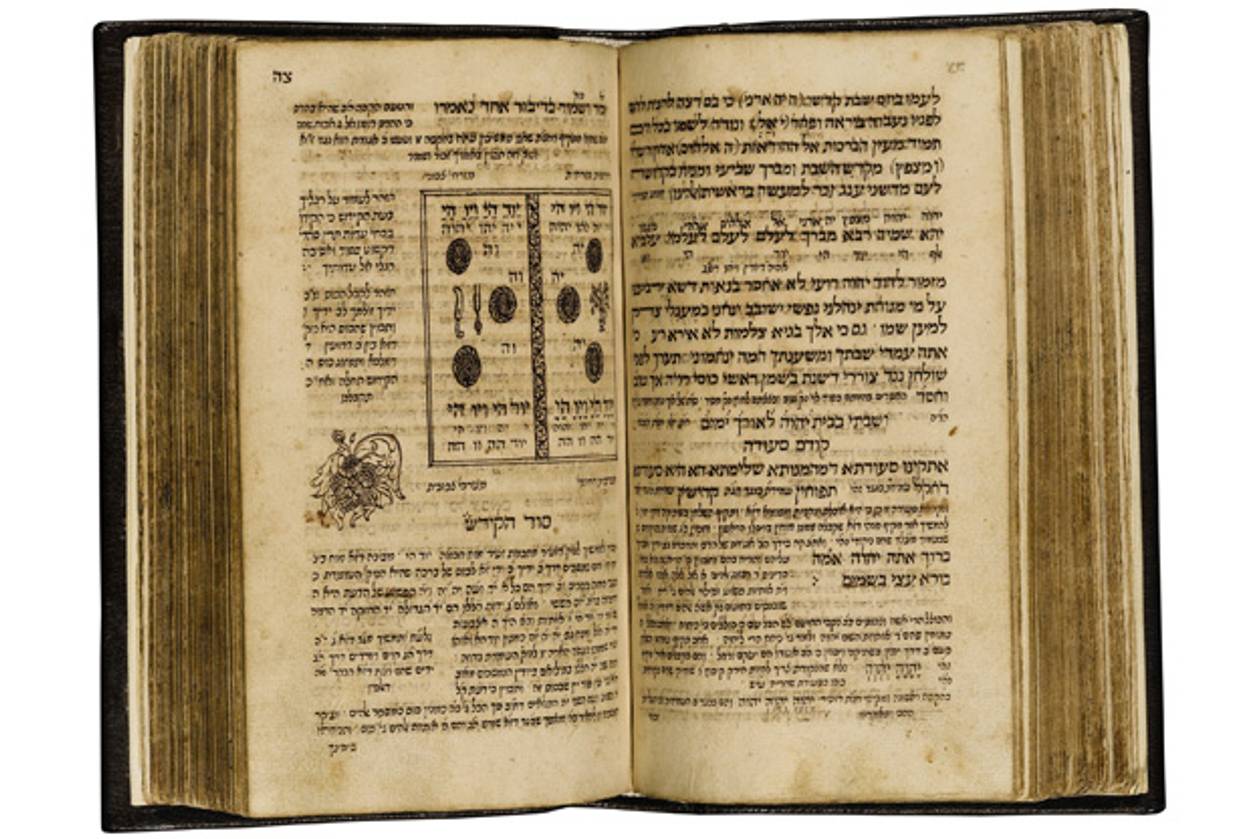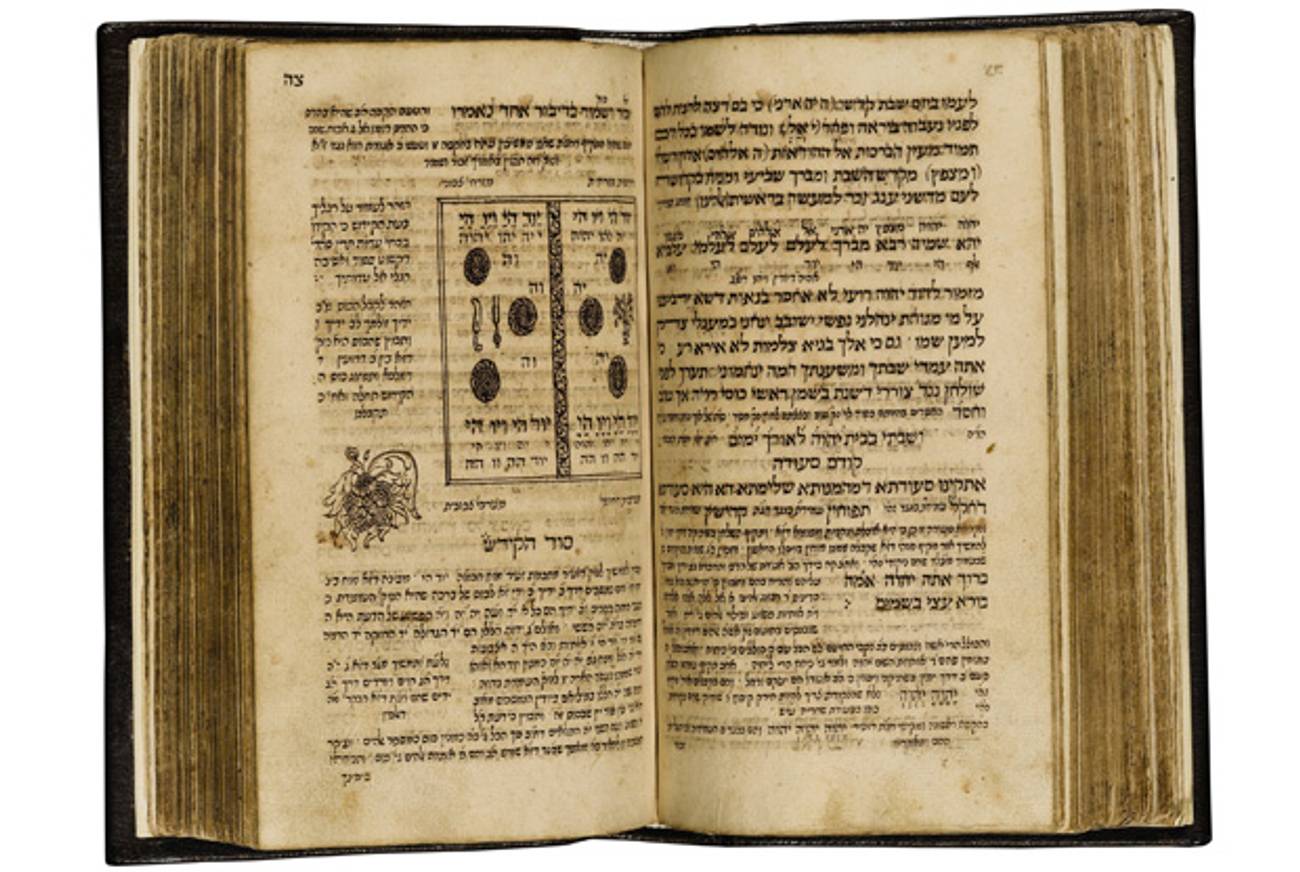Holy Tears
Sotheby’s hosts a Judaica sale and an Israeli auction




The highlight of next week’s annual Judaica auction at Sotheby’s is the Siddur ha-Besht, one of only two extant, hand-written prayer books once owned by the founder of Hasidism, Rabbi Israel ben Eliezer (a.k.a. the Baal Shem Tov), 1698-1760. This exceptionally rare example of a Kabbalistic siddur, one of only three or four surviving objects known to have been used by the Besht during his lifetime, has something for everyone: meticulous calligraphy (by Moses, son of Joseph of Luboml, a professional scribe who included refined illustrations to elucidate the Kabbalistic concepts found in the text); beautiful illustrations (including unicorns!); the authentic nusach ha-Ari liturgical text; and even a stained page of the High Holiday viduy prayer that is believed to hold the remnants of the great rabbi’s penitential tears. I was dubious about this last claim, until Sharon Liberman Mintz, Sotheby’s senior consultant for Judaica and curator of Jewish art at the Jewish Theological Society Library, opened the book to those mesmerizing pages. Unmistakable stains (clear, with a dense residue) and smeared, diluted ink appear only on the viduy, sloping vertically towards the bottom; once you see it, it’s hard to question the assertion.
Provenance has always played a significant role in the value of art. Work by one of the great Renaissance masters that was included in the collection of Vasari or a Medici, or a painting gifted by Picasso to Braque, or a photograph by Alfred Stieglitz of his wife Georgia O’Keefe that remained in her possession until her death: These would inevitably go for more at auction than the same work without the esteemed lineage. Such provenance would not, however, increase the estimate by 2,000 percent, as is the case here. The sale of the Baal Shem Tov’s siddur—the prayer book that was used daily by the man responsible for the promulgation of the notion of religious ecstasy—raises interesting questions about the evolving role of unique provenance and yichus in the pricing of rare Jewish manuscripts. This rare and remarkably well preserved manuscript, which has been handed down, from father to son, through the generations of the Chernobyl Hasidic dynasty, could be yours for an estimated hammer price of $450,000-$650,000. Considering the unprecedented connection to the Baal Shem Tov, however, it’s anyone’s guess how high this item will go. The siddur has been publicly exhibited only once before, in Tel Aviv in 1960, in an exhibition commemorating the 200th anniversary of the Baal Shem Tov’s death. You can see this bookworm’s dream at the auction preview (Lot 91).
Another highlight of the Judaica auction is an exceptional miniature woman’s prayer book, hand-written in Central Europe in 1721 (Lot 90). Fitting neatly inside the palm of the hand and illustrated with nearly a dozen refined depictions of wealthy 18th-century Jewish women’s daily lives: the recitation of the blessings over candles, preparation of dough, entering a tub as a maidservant pours water, picking fruit from a tree, reciting the Shema while perched on the edge of the bed. The detailed illustrations recall engraving techniques popular at the time and are distinctive in their accomplished use of perspective and depictions of detailed garments and domestic interiors. Executed in a vaguely Rococo style, they even include a scene of women playing cards, something permitted during the holiday of Hanukkah. This was a luxury item at the time that it was commissioned, and can now be had for an estimated $180,000-$200,000.
Isidor Kaufmann’s sumptuous and virtuosic portrait of a young bride with a resolute and wistful gaze, Newlywed (Lot 55), includes the opulent detail and sensitivity to texture for which Kaufmann is known. His refined and luminous brushwork against a deep crimson background is not to be missed (estimate $250,000-350,000).
Sotheby’s annual Israeli and International Art auction, which coincides with the Judaica sale, is also in previews this week. Highlights include Nachum Gutman’s kinetic 1950s painting of waves crashing against the promenade of Jaffa Harbor (Lot 24); Ori Reisman’s House in Acre (Lot 63) and Tel Aviv Harbor (Lot 65), with its bold use of color and flattened planes; Moshe Gershuni’s large, abstract, translucent, and gestural recent painting, in acrylic and gel, Untitled (Lot 71); and Sigalit Landau’s contemporary epic video work, Under the Dead Sea (Lot 78), which was included in her recent Museum of Modern Art exhibition and is one of the most visually striking and substantively nuanced time-based media works to come out of Israel in the past decade (its display here, on shiny black television monitor, does not do it justice).
One surprise: photography has a much smaller presence at this year’s Israeli art auction than it has in years past. The central motif of a lonely, potted cactus is a central theme in the work of Asim Abu Shakra, an Arab Israeli artist who died in 1990 at age 29. His works are enjoying an increased and deserved presence in exhibitions and auctions, although the work for sale this year, Cactus (Lot 62), has a dull patina and dark opacity that detracts from the moving image, which references a sense of not belonging and transplanted foreignness. It would be well served by a good re-stretching and reframing. Regardless, it is encouraging to see the increased presence of Arab Israeli artists at the sale.
The focus of this year’s auction is on three Chagall oils (Lots 13-15) depicting the interiors of synagogues painted during his stay in Palestine in 1931 (the Chagalls will be the the subject of a forthcoming Tablet Magazine article) as well as a rare, early Reuven Rubin, The Drummer of Meron, ca. 1929 (Lot 12). And the auction’s star is Chagall’s Interior of the Yemenite Hagoral Synagogue, Jerusalem, 1931 (Lot 14), which recalls the work of Matisse and Bonnard in its decadent use of rich pattern and textile; its wide range of deep pastel hues demonstrates Chagall’s virtuosity as a colorist. He captures the interior of an historic synagogue, including the ark (still in existence today), Torah scrolls, and a young boy studying on a sofa as the bright Jerusalem light peeks through the small window panes to illuminate a space that is at once cavernous and expansive, dreamy and dreary: a confluence of experience that is one of Chagall’s greatest strengths.
Sotheby’s Important Judaica auction, Wednesday, December 14, 10 a.m. Sotheby’s Israeli and International Art Auction, Wednesday, December 14, 2 p.m. All auction items, including the Siddur ha-Besht, are on public view today through Tuesday at Sotheby’s.
Maya Benton is a curator at the International Center of Photography.